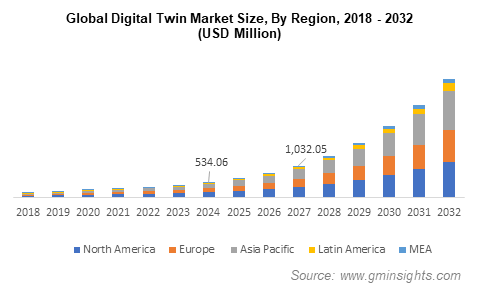Digital Twin Market size worth $90 Bn by 2032
Published Date: October 2022
Digital Twin Market size is set to exceed USD 90 billion by 2032, according to a new research report by Global Market Insights Inc.
Businesses with a complete digital footprint of products are increasingly incorporating digital twin technology as it allows them to identify physical issues sooner and track outcomes precisely, enhancing product quality and life cycle. The technology, which connects the real and virtual worlds, is emerging as a major disruptor in Industry 4.0. Improved operational efficiency offered by the tech and ongoing R&D projects are broadening its scope of application across numerous sectors, including manufacturing, retail, healthcare, energy, and aviation, which is likely to supplement overall market revenue growth.
Rising cyber threats might impede the market growth
An upsurge in real-time cyber-attacks is harming businesses across varied industries, particularly those that lack a proactive and predictive strategy to combat cybercrimes. Organizations might suffer a significant loss because of data theft due to such attacks, which is inhibiting the implementation of digital twins. However, as technology advances in the coming years, digital twin technology is projected to gain prominence as a solution for reducing cyber-security threats and become a crucial component of an in-depth defense system.

Get more details on this report - Request Free Sample PDF
Accurate fault detection to bolster adoption in product design and development applications
In terms of application, the product design and development segment held over 40% share of the digital twin market in 2022. The segment semand is driven by the mounting demand for digital twin technology in product design and development applications owing to the rising need for forecasting accurate outcomes, enhancing product efficiency, rapidly detecting defects, and refining product quality. Additionally, the technology speeds up the designing process, improving the time-to-market for new products.
Browse key industry insights spread across 270 pages with 175 market data tables and 43 figures & charts from the report, “Digital Twin Market Size By Application (Product Design & Development, Machine & Equipment Health Monitoring, Process Support & Service), By End Use (Manufacturing, Healthcare, Automotive, Aerospace & Defense, Energy & Utility, Infrastructure Buildings, Retail & Consumer Goods), COVID-19 Impact Analysis, Regional Outlook, Growth Potential, Competitive Market Share & Forecast, 2023 – 2032” in detail along with the table of contents:
https://www.gminsights.com/industry-analysis/digital-twin-market
Technological edge offered by digital twins to boost adoption by healthcare end-users
As per the report, the healthcare end-use segment is expected to grow at more than 30% CAGR between 2023 and 2032 on account of the widespread utilization of machine learning (ML) and artificial intelligence (AI) in the healthcare sector, which is strengthening the digital twin technology to provide real-time data and analytics to increase patient safety. Furthermore, prominent research projects involving digital twins are exploring their usage for facilitating individualized treatment, controlling chronic illnesses, preventing severe trauma by combining them with agents and multi-agent systems, and managing public health situations.
Strategic partnerships to define the competitive landscape
The digital twin market consists of AVEVA Inc., ABB Group, Ansys Inc., Bosch Rexroth AG, Accenture Plc, Schneider Electric Inc., Microsoft Corporation, IBM Corporation, Autodesk Inc., TIBCO Software Inc., Infosys Ltd., Capgemini SE, Rockwell Automation, Oracle Corporation, Siemens AG, and Wipro Ltd., among other companies. The leading competitors in the industry strongly focus on offering novel technologies through strategic alliances.
Preeti Wadhwani, Smriti Loomba